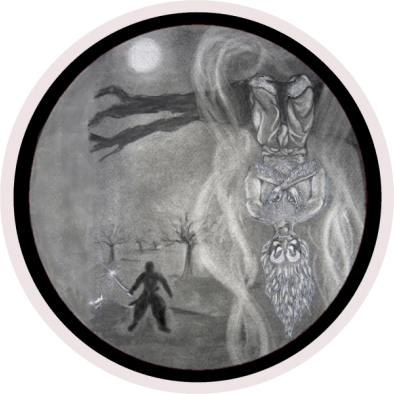Vetala Vampire

The Persians were one of the first civilizations thought to have tales of such monsters. Creatures attempting to drink blood from men are depicted on some excavated pottery shards.
Where does the word "vampire" itself come from?
In Polish language there is a perfectly kept nasal sound in the word "wąpierz", which in Old Polish sounded like "vampier". In Serbo-Croatian that word is "vàmpīr".
In Albanian there is a word "dhampir". A compound formation of "dham" (Gheg variant of "dhëmb" meaning tooth) + "pir" (participle of "pi" meaning to drink), both meaning literally "the one who drinks through his teeth".
Old Church Slavonic "ǫpyrь/ѫпырь" cloud be a proto word for this name. The basic form of "ampir" with added "v" in the beginning just like with a word for a snake "ǫ̃žь" with added "v" making "vǫ̃žь".
This initial nasal sound in the East Slavic languages transformed into "u" following the common rule, thus creating "upir".
Old East Slavic: упирь (upirĭ)
Belarusian: ўпір (ŭpir), упір (upir), вупар (vupar)
Russian: упырь (upyrʹ)
Ukrainian: упир (upyr)
In the South Slavic branch that sound transformed or stayed as "am" or "an" or "a".
Bulgarian: вампир (vampir), въпиръ (vǎpir), вепир (vepir)
Macedonian: вампир (vampir)
Serbo-Croatian: вампир, упир, vampir, upir
In the Polish language all forms are present.
Polish: wupi, wuki, wąpierz, łupirz, upiór
Roman Empire and striges
In Latin "strix" meant an owl.
In the late Roman period this word became associated with witches or a type of ill-omened nocturnal flying creature. It referred to night-time entities that craved human flesh and blood, particularly of infants.
Strigoi in Romanian mythology are troubled spirits that are said to have risen from the grave. They are attributed with abilities to transform into an animal, become invisible, and to gain vitality from the blood of their victims.
Slavic strzyga or striga sucked blood, she gouged the viscera and slipped in the form of an owl at night. In Slovakian "striga" also means a witch.
Hindu Vetala
Sanskrit वेताल vetāla is a ghost-like being. The vetala are defined as spirits inhabiting cadavers and charnel grounds. These corpses may be used as vehicles for movement (as they no longer decay while so inhabited). A vetala may leave the body at will. The vetala is described as an undead creature who, like the bat associated with modern-day vampirism, hangs upside down on trees found on cremation grounds and cemeteries. Pishacha, the returned spirits of evil-doers or those who died insane, also bear vampiric attributes.
Hittite Zawalli
Hittites believed in a malevolent and unpleased soul of the deceased ("akkant-") called Zawalli (GIDIM).
Article created on the 7th of April 2019.
